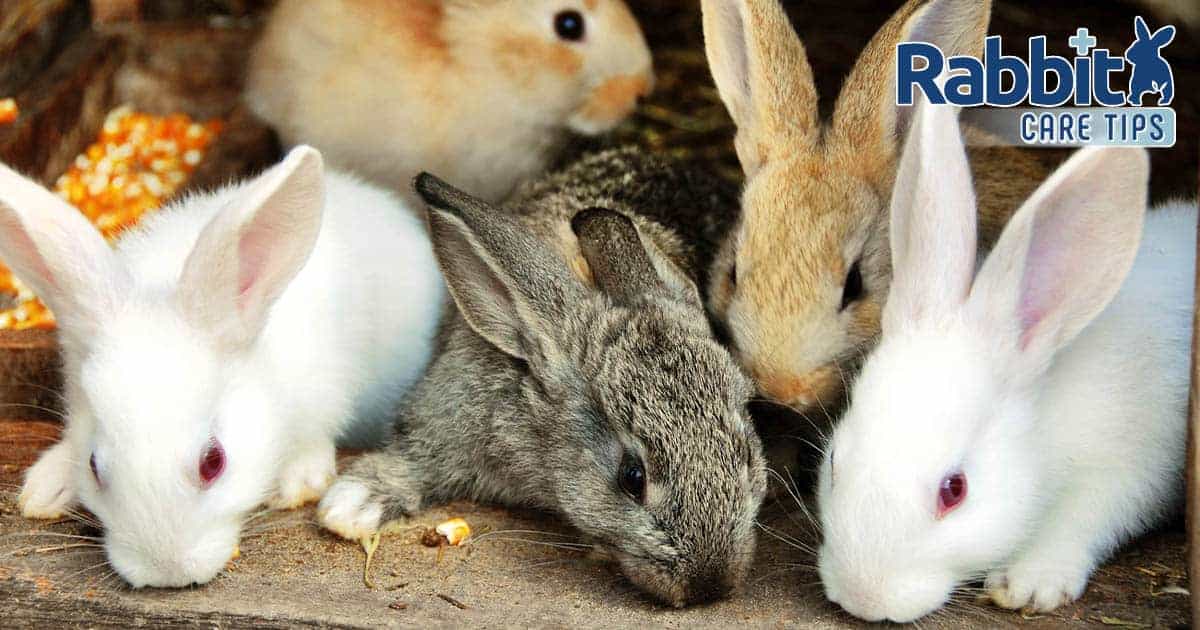One of the joys of owning a pet rabbit is the love and affection that these adorable animals provide. A wide array of breeds are very loving towards their owners, so they quickly become a cherished part of the family.
Most rabbits adore human company, but some are easier to bond with than others. Harlequins, Lionheads, Rex, Polish, and Mini Lop rabbits are particularly cuddly. Dutch, Jersey Wooly, Himalayan and Chinchilla rabbits are easy-going and cheerfully tolerate handling.
Every rabbit has a unique personality, so choosing a breed and hoping for the best is not enough. Spend time with a rabbit before permanently bringing it into the family. We will help you decide which breeds of rabbit to focus upon, narrowing down your search criteria considerably.
Do Rabbits Make Good Companion Pets?
Bringing a rabbit into your home is a huge responsibility. Rabbits aren’t low-maintenance starter pets. They require lots of attention. If you meet their day-to-day needs, you’ll have a new best friend.
The American Rabbit Breeders Association recognizes 50 different breeds of rabbit. So, you’ll have lots of options when choosing a pet for your family. Every breed of rabbit has different personality traits and quirks.
Top 15 Most Friendly Rabbit Breeds – Best Rabbit Breeds for Kids
All rabbits are friendly and affectionate. Bunnies are social animals, and loathe being alone for long periods of time. This means that any rabbit will enjoy spending time with humans.
What interaction they enjoy differs between breeds. Rabbits are often skittish due to their status as prey animals. This means that being handled does not always come naturally. Patience and understanding are required.
A house rabbit should be comfortable with being petted, especially if you have children. With this in mind, the friendliest breeds of rabbit that are ideal for any home include the following:
- Harlequin Rabbit
- Rex Rabbit
- Jersey Wooly Rabbit
- Dutch Rabbit
- Mini Lop Rabbit
- Chinchilla Rabbit
- Polish Rabbit
- Lionhead Rabbit
- Californian Rabbit
- Himalayan Rabbit
- Sussex Rabbit
- Havana Rabbit
- Florida White Rabbit
- Palomino Rabbit
- Thrianta Rabbit
Let’s take a more detailed look at each of these bunnies. With more information, you can build the ideal environment for your pet.
1) Harlequin Rabbits as Pets
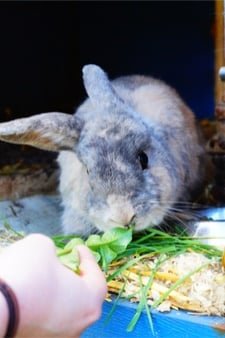
Hailing from France, Harlequin rabbits take their name from their distinctive fur markings. These bunnies love human interaction, making them great companions.
As the name suggests, Harlequin rabbits are the clowns of the bunny world. They live to entertain, so you’ll forge an effortless bond in no time at all.
Harlequin rabbits are energetic, and should roam free whenever it’s safe to do so. They’re very docile and will enjoy being petted and stroked.
Above all, a Harlequin rabbit should always be the center of attention. If you shower your Harlequin with affection, it will return it in spades. Expect plenty of demands for cuddles and petting from a Harlequin.
2) Rex Rabbits as Pets
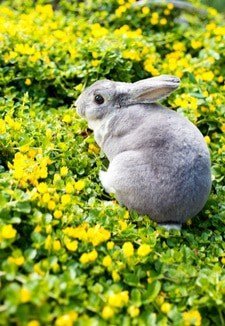
There are many different sub-breeds of the Rex rabbit. Members of this family all have similar temperaments, though. They welcome human interaction.
Rex rabbits are maternal and protective. This makes them great companions for seniors or single people. They’ll always be keen to keep you company, day and night.
Rex rabbits are very intelligent. This means they can be trained to use a litter tray. This, coupled with their limited grooming needs, makes them the most popular rabbit in the country.
Rex rabbits prefer being petted and scratched to being held. This is especially prevalent in the mini Rex breed. They will squirm if they’re held too tightly. Avoid distressing a Rex by insisting on cuddles.
3) Jersey Wooly Rabbits as Pets
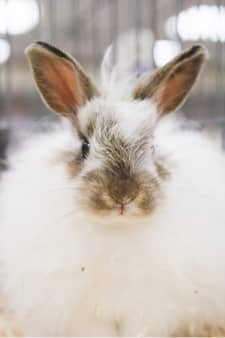
The Jersey Wooly is the perfect companion for anybody with limited mobility or energy. These dwarf-sized bunnies are much lazier than most rabbits. They’ll happily cuddle on the sofa for hours.
This breed is also famed for its docility. The Jersey Wooly is often informally called the ‘no-kick bunny.’ This makes them safe for children to interact with.
As this breed is so small, they can also dwell in a more compact enclosure. This makes them ideal for small houses or apartments. Just let them out, and enjoy the attention they provide.
The only note of caution for the Jersey Wooly is their grooming requirements. Their thick fur will need to be brushed daily. This affords further opportunities to bond with this loving bunny, though.
4) Dutch Rabbits as Pets
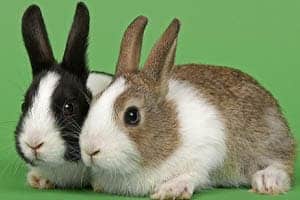
The name of these rabbits is misleading, as they hail from England. That’s the only complexity that surrounds these bunnies. They are loving and easy pets to maintain.
One of the best things about Dutch rabbits is their calm demeanor. These rabbits are easygoing and affectionate. A Dutch rabbit will be nonplussed by children, no matter how chaotic. They actively enjoy being held and go with the flow.
Dutch rabbits are small – only just larger than a dwarf breed. They pack a lot of energy into that little frame. This bunny requires exercise and fresh air. Unleash them in the garden with your children to meet their needs.
5) Mini Lop Rabbits as Pets
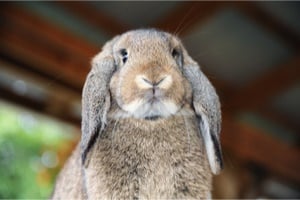
Arguably more than any other breed, the Mini Lop was born to be a pet. They look like teddy bears and love to be showered with affection. They return this adoration without question.
Mini Lop rabbits are also intelligent. This works in your favor, as it means they can be litter trained. They require constant entertainment, though. Fill their hutch with toys, and arrange exercise for your rabbit.
Mini Lops and children can be a great match. This breed is loving, and will enjoy being petted, held and cuddled. They’re also energetic, so bunny and child will tire each other out.
The only note of caution with Mini Lops is that they can become overstimulated. Over-excitement brings out the worst in a Mini Lop, and they may bite in their exhilaration. It’s safer to pair this breed with older, calmer children.
6) Chinchilla Rabbits as Pets
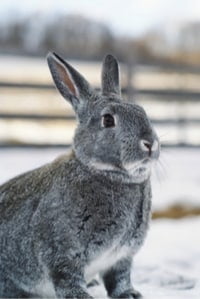
The Chinchilla rabbit is a comparatively young breed. Don’t be fooled by the moniker; they’re not related to chinchillas. The name comes from this breed’s distinctive gray coat.
Chinchilla rabbits are easy-going and enjoy human company. Due to their larger size, they should be released from their hutch often. This doesn’t mean they need to run free, though.
Chinchilla rabbits are not particularly energetic, and will often be found relaxing on the floor or sofa. This makes them loving pets for anybody looking for a lower-maintenance rabbit.
It’s best to introduce children to a chinchilla rabbit while the bunny is young. If you do so, the rabbit will welcome their presence. They enjoy petting, and will happily tolerate handling.
7) Polish Rabbits as Pets
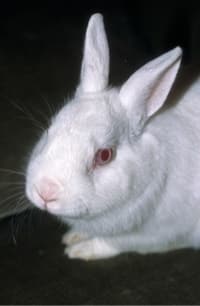
Few bunnies are more suited to life as an indoor pet than the Polish rabbit. This dwarf-sized breed is tiny and can contentedly live in a smaller hutch.
As the Polish rabbit is quite lazy, they also require limited exercise. Instead of running around, a Polish rabbit is likelier to seek cuddles. A bonded Polish rabbit is among the most affectionate of all bunny breeds.
Polish rabbits will fascinate children as this is the breed that magicians pull from hats. The bunny will be equally enamored with a child that wants to pet and cuddle them.
The only note of caution surrounding Polish rabbits and youngsters is the bunny’s small frame. They are so small that they can easily be dropped.
8) Lionhead Rabbits as Pets
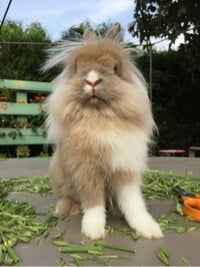
The Lionhead rabbit is among the most loving and affectionate of all bunny breeds. This rabbit doesn’t just tolerate being handled. They actively welcome it.
Lionhead rabbits are also more playful than many rabbit breeds. They enjoy entertaining humans and find children delightful. If a Lionhead rabbit is being showered with attention, it’ll be perfectly happy.
All of this sounds like a Lionhead rabbit is a perfect first rabbit for youngsters. Unfortunately, Lionheads also need a great deal of care.
This breed is initially timid, and will bite and nip when afraid. The trust of a Lionhead rabbit must be built slowly, steadily and calmly.
Also, Lionhead rabbits require near-constant grooming. Their name arises from a genetic mutation, which produces a mane of hair around the neck. Some children will lack the patience needed to manage this.
Lionheads make affectionate bunnies for committed owners. If you demonstrate the patience they require, this breed is the ideal companion.
9) Californian Rabbits as Pets
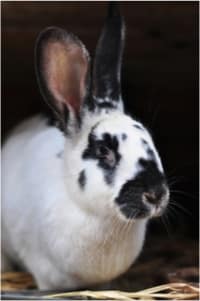
Californian rabbits are affectionate and love to cuddle. There is one caveat, though. This breed is initially shy. You need to earn the love of a Californian rabbit.
This means that Californian rabbits are not ideal for children. They won’t bite, as they’re a docile breed. They will be afraid and anxious which can lead to health concerns.
Once you have bonded with a Californian rabbit, let it call the shots. If you wait for your bunny to approach you, you’ll reap the rewards. You’ll find that your bunny rarely leaves your side.
Californian rabbits will hop into your lap and ask for petting once you’ve gained their trust. Let your bunny roam around the house and it’ll soon come to find you.
10) Himalayan Rabbits as Pets
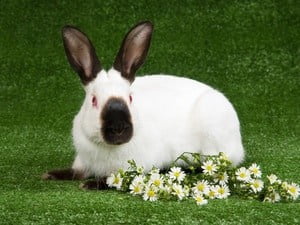
This is the oldest known rabbit breed in the world. As a result, they’ve had plenty of time to adjust to domesticity.
Himalayan rabbits are very loving and docile, and they’ll welcome the human company. They need time outside their hutch. This doesn’t necessarily mean exercise, though.
Himalayan rabbits need to run a little, but what they love most is sunshine. If you have a back yard, allow your Himalayan to relax with you outdoors. They enjoy cuddling up with their owners and soaking in the sun’s rays.
Patient, calm and small enough for anybody to carry, Himalayan rabbits make loving family pets. Just make sure they get sufficient sunlight.
11) Sussex Rabbits as Pets
Bred in the 1980s by crossing Lilac rabbits and Californians, the Sussex is a beautiful, medium-sized rabbit with a compact body. Docile and affectionate, the Sussex weighs around seven pounds fully grown and has a life expectancy of six to eight years.
The Sussex rabbit is a lovely cream or gold color, with a short, dense coat. Best suited to living indoors, these rabbits also enjoy time exploring the great outdoors.
An excellent pet for families with children, Sussex rabbits are affectionate and love attention. This breed can be a bit naughty, though, so be sure to keep an eye on them when they’re out of their enclosures, and especially outside!
While Sussex rabbits have no particular health issues, they tend to overeat, leading to obesity and further health problems. Be careful not to overfeed your cute little friend, as they may not know when to say when.
12) Havana Rabbits as Pets
Sometimes described as “mink-like,” Havana Rabbits are a medium-sized breed with rounded, compact bodies. Bred in Ingen, Holland in 1989, Havanas earned the nickname “The Fireye From Ingen,” as their eyes appear to glow red from certain angles.
The Havana Rabbit has a sleek, short coat and might be colored blue, black, or chocolate. The breed gets its name because the chocolate-hued variety resembles the color of a Havana cigar.
A gentle, calm, and sometimes playful rabbit, the Havana is a great choice for a pet. They’re sociable with people and also with other rabbits. Havana Rabbits need lots of exercise and stimulation, and are suitable as pets for children.
13) Florida White Rabbits as Pets
In the 1960s, Judge Orville Miliken bred the first Florida White Rabbits by crossing Albino Dutch Rabbits, New Zealands, and Red-Eyed White Polish Rabbits. The Florida White, named for Judge Miliken’s home state, are small, compact rabbits that, as adults, will weigh between four and six pounds.
The Florida White Rabbit has a short, soft, exclusively white coat and red-hued eyes. The breed has a lifespan of five to eight years and isn’t prone to any particular health problems.
With a docile and quiet temperament, the Florida White is a good choice of pet for families with children who wish to raise a rabbit indoors. Florida Whites can live outside but are better socialized when kept indoors.
14) Palomino Rabbits as Pets
First bred in the 1950s and originally called the Washingtonian Rabbit, the Palomino is a medium-sized rabbit that will grow to between eight and ten pounds. Docile and sweet, Palominos should live between five and eight years.
The Palomino comes in two color varieties, the Golden and the Lynx. The Golden has a cream or beige surface coat with a white undercoat. The Lynx Palomino sports a silver or grey surface coat fading to white, beige, or cream. Both types have coats of coarse, short to medium fur.
Friendly, low-maintenance rabbits, Palominos make excellent first-time pets for rabbit lovers of all ages.
15) Thrianta Rabbits as Pets
The story of the Thrianta Rabbit is the story of a breed that very nearly didn’t survive. First bred in 1930s Holland by breeder H. Andreae as a tribute to the Royal House of Orange, the Thrianta Rabbit flirted with extinction when it became a primary food source for soldiers during the Second World War.
Thankfully, a few survived, and these were mated with German Rabbits to produce the modern breed of Thrianta. A medium-sized rabbit with a compact body, the Thrianta will weigh from four to six pounds at maturity. The lifespan of the Thrianta Rabbit is between seven and ten years.
The Thiantra’s short, thick coat is an unmarked, beautiful fire-red. Docile and gentle, this breed is child and first-time-owner safe and has no particular health concerns.
Which Rabbit Breed is Most Child-Friendly?
Before adopting a bunny as a child’s pet, there are several things to consider. These include:
- Temperament. You need a rabbit that will not bite, scratch, or kick while being handled.
- Size and Weight. Your child should be able to pick a rabbit up comfortably. Smaller bunnies are delicate and get hurt if dropped.
- Activity Level. Always find a pet that matches a child’s energy levels. Lazy bunnies grow weary of being expected to play regularly. Energetic rabbits get frustrated if they feel cooped up.
- Maintenance. Rabbits can be a lot of work. Ensure that a child is prepared to meet a rabbit’s cleaning and grooming needs.
It’s hard to look past the Harlequin rabbit. These bunnies love people, grow to a child-friendly size and weight, and can be taught tricks.
If a Harlequin rabbit is not an option, consider a Dutch rabbit instead. These bunnies love to exercise, and are very tolerant of handling. This means that they’ll contentedly play with a child for hours.
The ever-popular Mini Lop is always an option. These bunnies are adorable, and will become a constant companion for your child. Just supervise playtimes and don’t allow a Mini Lop to get too agitated.
Few things are as rewarding as the mutual adoration of a pet rabbit and its owner. But, before you introduce a bunny to your family, find out the pros and cons of having a pet rabbit and also see our article about Does a Rabbit Make a Good Pet for a Child?
Best Outdoor Rabbit Breeds
1) Belgian Hare Rabbits as Pets
Closely resembling the Wild Hare, the Belgian Hare is a large rabbit, weighing six to nine pounds at maturity. First noted in eighteenth-century Belgium, the breed was imported to England in 1856. Breeders William Lumb and Benjamin Greaves developed the modern breed of Belgian Hare in 1873.
The Belgian Hare has a coat of short, glossy, rust-colored fur in a radiant reddish-orange tint.
Belgian Hares prefer outdoor enclosures and are bred primarily as show rabbits. Active and sweet, Belgians are nonetheless a nervous breed and are easily startled, making them a less than ideal pet for children.
2) Netherland Dwarf Rabbits as Pets
Described as having “babyish” features and weighing only two pounds at full size, the Netherland Dwarf is the smallest domesticated rabbit breed. Its small size and short, thick body type make it a very popular rabbit in Japan, where it fits right into “kawaii,” or the Japanese “culture of cute.”
The Netherland Dwarf Rabbit was bred in the early 1900s by Jan Meyering. The breed comes in many colors, including black, turquoise, and opal.
While the Netherland Dwarf is undoubtedly adorable, it is, unfortunately, not a lap-pet. Neither are they suitable for small children, as they have an alert, energetic temperament closely resembling that of the Wild Hare.
3) Britannia Petite Rabbits as Pets
The Britannia Petite Rabbit evolved naturally from the Polish Rabbit. First noted in England in the 1800s, the Britannia Petite has since been selectively bred to produce a rabbit with a more upright stance and fine bone structure. In England, the Britannia Petite is still called a Polish Rabbit; because the ABRA already recognizes a breed by that name, it is referred to in America as the Britannia Petite.
A dwarf-sized rabbit, the Britannia Petite will weigh between two and two-and-a-half pounds at full size. Active, if a little nervous, Britannias prefer the outdoors and can even be trained to jump obstacles, thanks in part to their arched body type.
This breed has a short, soft coat in four color varieties: the Red Eyed White, the Blue Eyed White, Black/Sable, and Chestnut.
4) Beveren Rabbits as Pets
There is some debate about whether the Beveren Rabbit originated in Beveren, Belgium, or England. A large rabbit, weighing eight to twelve pounds at adulthood, the Beveren has a mandolin, or semi-arch body type, and a life expectancy of between five and ten years.
The Beveren Rabbit has a short, dense coat of soft fur. The breed comes in various colors, though only three are recognized by the American Rabbit Breeders Association: solid blue, solid black, and blue-eyed white.
Intelligent, docile, and curious, the Beveren Rabbit prefers the outdoors and loves to explore.
5) Lilac Rabbits as Pets
H. Onslow Cambridge first exhibited the Lilac Rabbit in the early 1900s, and the breed was introduced in the United States and Canada in 1926, where it quickly caused a splash.
A medium-sized rabbit, the Lilac weighs between six and eight pounds when mature and has a compact body shape. The breed has a generous lifespan of nine to twelve years on average.
The Lilac Rabbit has a coat of short, soft fur colored a beautiful lavender or lilac hue. These docile and friendly beauties are gentle and prefer to be kept outdoors.
6) Blanc De Hotot Rabbits as Pets
A larger-sized rabbit, the Blanc De Hotot will grow to weigh between eight and eleven pounds by adulthood. The breed as we know it today was perfected in Hotot-En-Auge, Normandy by Euginie Bernhard.
The Blanc de Hotot boasts a short coat of soft white fur and dark brown circles around the eyes, known as “eyeliner.”
Active, friendly, and affectionate, Blanc de Hotot Rabbits make wonderful pets. Like all domesticated rabbits, though, they should be socialized as early as possible. This breed prefers the outdoors but is sensitive to extreme heat and cold.
7) English Spot Rabbits as Pets
One of the world’s oldest surviving rabbit breeds, the English Spot has been around since the mid-1800s and was first introduced to North America in 1910. English Spot Rabbits are a medium-sized breed, weighing five to seven pounds as adults. Friendly and curious, English Spots have a full arched body and an average life expectancy of five to nine years.
English Spots have beautiful coats of short, dense fur and come in various colors, including black, blue, turquoise, chocolate, gray, lilac, and gold. There are markings on the English Spot, too, such as butterfly-shaped markings around their noses, eye-circles, cheek spots, colored ears, and spots down the spine.
This sweet, affectionate breed makes a great pet but prefers to live outdoors.
8) American Blue/White Rabbits as Pets
Bred in 1917 by Lewis H Salisbury of Pasadena, California, the American Rabbit is a medium to large-sized, arch-bodied breed that should grow to between nine and twelve pounds. Quiet and docile, the American Rabbit will live an average of eight to twelve years.
The American Rabbit comes in two varieties, American Blue and American White, named for their soft, satiny fur colors.
While normally calm and docile to the point of laziness, American Rabbits are skittish around people, making them less desirable as an indoor or family pet. Nor does this breed take well to being handled, especially by inexperienced hands, so this is not a good choice of rabbit for a child.
9) Gotland Rabbits as Pets
Indigenous to Sweden, the Gotland Rabbit developed naturally over time. Modern Gotlands are descendants of Rabbits discovered on Gotland Island in the 1970s. Today, there are breeding programs to keep this breed from becoming extinct.
Gotlands are medium-sized rabbits with compact bodies. The Gotland should weigh between six-and-a-half and eight-and-one-half pounds at maturity and has an average life expectancy of nine years.
This breed has fine, usually straight short coats that may be nearly any color. Likewise, Gotland Rabbits may have any color eyes.
10) Deilenaar Rabbits as Pets
First exhibited by a Mr. Ridderhof in Deli, Netherlands, the Deilenaar is a compact, medium-sized breed that grows to between five and seven pounds. Like the Gotland Rabbit, the average lifespan of a Deilenaar is nine years.
Deilenaar Rabbits boast distinctively-colored dense, silky, medium-length coats. The base coat is a rich slate gray, while the intermediate color is a rusty brown. Finally, like the finishing coat on a layered painting, there’s the stunning red agouti fur featuring ticking and mackereling of black.
Friendly and lively, Deilenaars are a great choice of pet. They can be lively and prefer to live outdoors, though, and are therefore recommended for experienced rabbit owners.
Best Indoor Rabbit Breeds
1) American Fuzzy Lop Rabbits as Pets
When Holland Lops were bred with French Angora Rabbits to produce a long-haired Lop, the result was a breed that possessed a recessive gene for a long coat. In other words, only a very few long-haired lops could be bred this way. Patty Green-Karl is credited with having developed the long-haired cuties that displayed the recessive gene into the breed as it is known today.
A dwarf-sized, compact-bodied rabbit, the American Fuzzy Lop will weigh between three-and-one-half and four pounds fully grown. The coat of this breed is actually wool and can be made into yarn. All American Fuzzy Lops have distinctive markings on their noses, circles around their eyes, and tinted ears.
Known to be active, playful, and curious, the American Fuzzy Lop makes an adorable and affectionate pet. Like many rabbit breeds that prefer to live indoors, the American Fuzzy Lop likes ample time to romp and explore the outdoors, supervised, of course!
2) Holland Lop Rabbits as Pets
One of the most popular rabbit breeds worldwide, the adorable Holland Lop is a dwarf-sized rabbit with a compact body. At maturity, this breed will weigh between two and four pounds. Bred by Adriann de Cock in the 1950s, the Holland Lop has a lifespan of seven to fourteen years.
The Holland Lop Rabbit sports a dense, glossy, smooth coat that may be solid or broken in color. Solid-colored Holland Lops are either chestnut, chocolate, or chinchilla in hue, whereas the broken-colored variety comes in tortoise, seal, or sable mixtures.
Curious and affectionate, the Holland Lop makes an excellent pet for first-time rabbit owners. Though they prefer to live indoors, they enjoy time outside. Just be sure and keep an eye on your Holland Lop when you let them explore the outdoors.
See our lop eared rabbits care guide.
3) German Lop Rabbits as Pets
Bred in Germany and recognized as a distinct breed in 1970, the German Lop is a large rabbit, weighing between six and eight pounds at adulthood. This docile breed has a life expectancy of between nine and twelve years.
The German Lop has medium-length, dense fur that is recognized in the following range of different and exciting color varieties:
The agouti type is either chinchilla, chestnut, or opal. The broken variety is white with colored spots. A German Lop with blue, black, chocolate, lilac, or sable fur tipped with either gold or silver is known as ticked. Shaded lops have sable fur with either pearl, sable, or tortoise mixed in and, finally, the wideband variety is either cream, fawn, red, or orange.
Docile and affectionate, German Lops make great pets for first time rabbit owners, and for families with children.
4) Continental Gian Rabbits as Pets
A giant-sized rabbit with a mandolin, or semi-arched body type, the Continental Giant can grow to weigh anywhere from thirteen pounds to thirty-five-plus pounds. These friendly, docile rabbits will live, on average, from four to seven years.
The Continental Giant is one of the world’s oldest surviving rabbit breeds, having been around since the sixteenth century. They descended from the Belgian Hare and Belgium’s Flemish Giant Rabbits.
Sometimes referred to as “Contis” by their doting owners, Continentals have dense, thick coats of beautiful glossy fur. The breed comes in various colors, including white, light gray, steel grey, fawn, sandy, and black.
Obviously adorable, the Continental is also very smart. Pet Continentals have been known to play games, learn tricks, and even respond to their names. This breed prefers to live indoors but needs plenty of space due to its large size.
See our caring guide for giant rabbits.
5) Hulstlander Rabbits as Pets
First exhibited in 1977 Netherlands by J de Graaf, the Hulstlander is a small to medium-sized rabbit with a compact body. This striking breed weighs between five and six pounds at maturity and has an eight-to-ten year lifespan.
The Hulstlander’s luxuriant coat of dense, soft fur is white, displaying no off-white or yellowing of any kind.
Playful and intelligent, this breed enjoys being social and loves to be the center of attention. Hustlanders do best with a near-constant companion and dislike long stretches alone, making them wonderful pets for owners with lots of time, love, and attention to give.
6) English Lop Rabbits as Pets
The English Lop was first noted in England in the mid-1800s, but the breed may have its origins in Africa. A medium-sized rabbit with a semi-arched body and distinctive oversized ears, the English Lop should weigh nine or ten pounds fully grown and has a life expectancy of five to seven years.
English Lops have smooth, short coats that may be one of many colors, both broken and solid. They may be white, fawn, chinchilla, or blue, among other less popular colors.
Curious and friendly, English Lops make lovable pets. They like to be picked up and petted and will remain playful throughout their lives.
While English Lops are not prone to any particular diseases, this breed can develop health problems if their large ears aren’t adequately cared for. It would be best if you inspected your English Lop’s ears at least once a week to be sure wax isn’t building up. Also, it’s essential to keep its nails trimmed short, as this breed tends to step on its ears.
7) New Zealand Rabbits as Pets
The New Zealand Rabbit is not from New Zealand; it was, in fact, bred in the United States by crossing Belgian Hares and Flemish Giant Rabbits. A large-sized breed, New Zealands will weigh between ten and twelve pounds when fully grown. A suitable pet for rabbit lovers of all experience levels, New Zealands will live, on average, between five and eight years.
Sporting chic coats of short, soft fur, New Zealands come in various colors, five of which have been recognized by ARBA: red, white, black, blue, and broken.
Even-tempered, affectionate, and good with children, New Zealand’s enjoy sitting on their owner’s lap and being pet.
8) Brazilian Rabbits as Pets
Native to South America and Brazil, in particular, Brazilian rabbits may have been brought from Europe by Portuguese sailors. Brazilians are medium-sized rabbits, weighing between seven and eleven pounds at maturity.
Brazilian Rabbits have dense fur with thick undercoats. They vary in color, though most are shades of blue, black, and opal.
Social, gentle, and calm, Brazilians make great pets. They’re friendly and get along well with other pets. The breed is prone to infection and colds, though, so be sure not to expose your Brazilian to drafts or sudden temperature variations.
9) Flemish Giant Rabbits as Pets
As the breed’s name would imply, Flemish Giants are large rabbits, weighing between fourteen and twenty-one pounds. They have semi-arched bodies and coats of gorgeous thick, glossy fur.
The ARBA recognizes seven colors of Flemish Giant: black, blue, fawn, light gray, sandy, steel gray, and white.
Flemish Giants are excellent companion pets if you’ve got the room to accommodate a large, indoor rabbit. They are affectionate and enjoy lap-sitting, but a word to the wise: Flemish Giants grow nervous quickly if mishandled, so they may not be ideal for small children.
See our Flemish giant care guide.
10) Alaska Rabbits as Pets
Question: Where did the Alaska Rabbit originate? If you almost answered “Alaska,” then remembered the New Zealand Rabbit and smelled a trap, good for you! This breed was actually developed in Germany by Rabbit Judge Max Goth and named for the Alaskan Fox, whose coat he was trying to emulate with his new rabbit.
First exhibited in Europe in 1907, Alaska Rabbits are medium-sized, weighing between seven and nine pounds as adults. This intelligent, friendly breed will live between seven and ten years and have dense coats of long, glossy hair.
Alaska Rabbits are great pets for people who have children or other pets, as they are friendly, outgoing, and calm. Be sure to give your Alaska plenty of together time, as they love being with people.
11) Silver Fox Rabbits as Pets
When Walter B Garland of Ohio crossed Checkered Giants, Champagne de Argents, English Silvers, and American Blue Rabbits, he developed the second domestic rabbit breed to originate in America. Recognized by ARBA in 1925, the breed was initially called the American Silver.
A large rabbit with a life expectancy of five to eight years, the Silver Fox will grow to weigh between nine and twelve pounds. A scarce breed of domestic rabbit, the Silver Fox has what’s called a “standing coat,” which means it stands upright rather than lying flat. While the breed comes in many colors, only black Silver Foxes are recognized by ARBA.
The Silver Fox is even-tempered and calm, making it a great choice of pet for families with children who have enough room to accommodate a large rabbit.
Conclusion
Owning a domestic rabbit is a rewarding and enjoyable experience. All of the above rabbit breeds have the potential to be excellent pets; your particular circumstances will determine which breed might make the best companion for you and your family. Always remember that small children should be supervised, even when handling a rabbit breed known to be suitable for young people.

